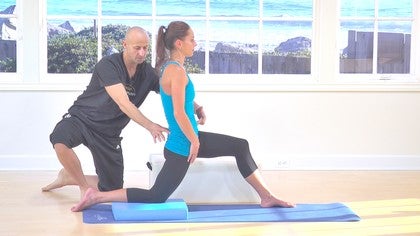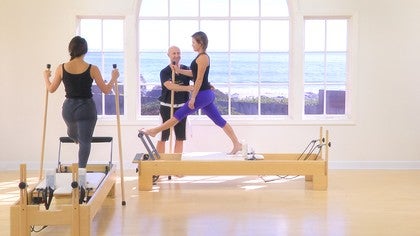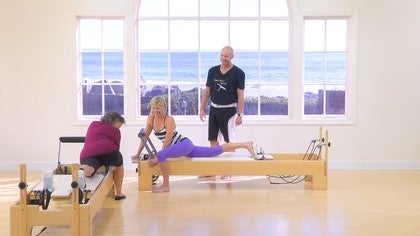Description
About This Video
Transcript
Read Full Transcript
Hip Flexors are Important Postural Muscles
Thanks for joining us, everyone. We're going to do a just 10 minute, 15 minute tutorial on the hip flexors. And we've chosen the hip flexors because they're such an important postural muscle and tight in so many people. So when I say postural muscle, I mean that they can have such an impact on your posture. And Meredith, if you can stand up and stand sideways, I'll demonstrate what I mean. There's actually 11 hip flexors, or 11 muscles that can flex the hip. So when we come to stretch them, we're going to change the angle of the hip or the pelvis a bit to make sure that we target all of them. But the main line of pull for the big hip flexors, like the psoas and iliacus, is to either lift the femur up or to pull the pelvis down towards the femur.
So you can imagine if they were tight that they could hold you in this sort of lordotic position over a period of time, which could cause some irritation in the lower back. So we're going to stretch them out. There's a guy named Basmajian, who was one of the very first researchers in muscle function, who says that the hip flexors are probably the most important postural muscle. So the other thing that happens is when the pelvis is tilted forward like this, you tend to get a corresponding kyphosis up here and then another one up here. So that your eyes are able to look ahead, you tend to tilt the head backwards. So they do have a profound effect on your posture. That looks really nice, Meredith. Come back to normal, and I'll show you the stretch, and you can explore it a bit. So if you come around here for a minute, I'll just demonstrate what we're going to do.
Two Lunge Hip Flexor Stretches
We'll do two stretches, because they both feel different. And as I said, there's so many hip flexors. There are some running more vertical. There are some running more this way, obliquely, and some out here. So we're going to rotate around a bit and make sure we target all of them. The first one we'll do this way. So you're going to have your foot in front of your knee, the hips square. And what you've got to make sure is that you do a posterior tilt before we start. Otherwise, once we start stretching, your back will be pulled into that lordotic position that we just looked at. OK? So if you want to come and try and get into position. Yeah. Good. So make sure that your foot is in front of the knee. Good. And we'll just put the box there for a bit of support, which is fine. And your hips are nice and square.
So let's start off by just tucking your tail or tilting your pelvis back. So if you think about it, if you were lying on the floor, it would be slightly imprinted, OK? And we do that by using the abdominal muscles. And let's see if we can tighten the glutes a little as well. Good. Now, in some people, that might already give them a stretch. You feeling that? And that's because what we've done is because we've tilted the pelvis posteriorly, we've moved some of the attachment points of the hip flexors away from the insertion points down here. How does that feel? Good. OK. So what we'll do is a contraction, which is-- if you think about what the hip flexors do, they do this. So for a contraction, you imagine that you're pulling that back leg or back knee forward, or you can press it into the floor. So one, two, three, four, five. Stop. Take a breath in. And then let's see if you can keep those glutes switched on and just lean your hips further forward-- good-- without letting your lower back arch. Good. How does that feel? Good. Great. Looks good.
The thing to make sure when you're doing this stretch is that you don't substitute a thoracic bend for a tail tuck. So keep the chest up. And remember, we're trying to tilt your pelvis. We're not trying to round the upper back. Good. So that's the good linear position. But as I said, because the hip flexors are all over this region, we can vary it a bit by-- let's just open your hips a bit and lean just a little bit. That'll move the stretching to your adductors, but also the adductors are hip flexors, some of them. So how does that feel? Nice. In particular, the adductor called pectineus and adductor longus are quite functional in hip flexion. Let's come back out of it a little. And we'll go the other way. So we're going to over-rotate, lean forward, and slightly outwards with your pelvis. Can you feel around more lateral? OK. And you can see that she just tightened the glutes to try and keep the pelvis in position. This is a stretch for tensor fasciae latae, the little muscle here, and the front of the gluteus medius, which is also a hip flexor, and gluteus minimus. Good. So how's that feeling? Yeah? Good. So again, remember, we're going to hold that position for about 10 breaths. If you want to come out of the stretch, we will do your other leg, but we'll do the other leg with a slightly different stretch.
A Deeper Lunge Stretch
Some people who are not as body aware as you or as strong as you might have trouble holding the pelvis in that posterior tilt. So this time, we'll do a lunge stretch, which makes it easier to get into position. The reason that I like that first one, though, is that it teaches good activation and stabilization of the abdominals and glutes. But this time, which leg are we stretching now? The left one-- so if you take your right foot forward to about here. Yeah. And you can put your hands, this time, inside here-- so this one, as well. Lower your hips as much as you can. And then take this leg back as much as you can. Good. OK. So take that foot a bit further forward. We don't want the knee on too sharp an angle. OK. You feeling any stretch here, yet? You are. Yeah. OK. So if you've got someone helping, they can assist by just pushing down. Do you want me to do that? Maybe a little. Just a bit? Yeah. Yeah, that's good. OK. So that's the first position.
You can see here that because the front legs there-- her pelvis is tilted slightly posteriorly, and the front leg blocks it from going into an anterior tilt. So it's easier to hold. OK. So let's contract. So push your back foot and knee down. So one, two, three, four, five-- stop. Take a breath in. Now, we can do two things to restretch. One is to just lean down a bit more. And then if she wanted to make it stronger, just tuck your toes under at the back. What you need to do here is just do this very slowly and carefully. Contract your quads just to lift the knee cap. See how you've come up a bit far there? Let's put it down again and I'll hold your hips down. Now try and lift your knee. I'm pretending I'm lifting. OK. You can-- just the tiniest bit. Good.
See how there's just a tiny gap there. Now, it doesn't matter if this leg's straight. But if you can just get it up a little bit, it'll make the stretch much more intense. It looks like it is, huh? Now, what about-- we rotate again to focus on the outside area here. So if you lift that knee up, and let's rotate this way. Yeah. You can adjust your hands. That's fine. Can you feel that more out here? Good. If you wanted to help-- do you want me to help? OK. I can hold down here and I can lift her leg up a bit this way. How's that? OK. Too strong? No, it's OK. OK. So put your knee down. Come out of this back to the middle. We won't rotate the other direction with this one. But you could, as well. OK.
So there's two pretty effective hip flexor stretches. As I said, most people are pretty tight there. So give it a go and see whether it's worth pursuing. I'm sure you'll probably find that it will be. I think so. OK. All right. Thanks.
Feel the Length: Innovations in Pilates
Comments
You need to be a subscriber to post a comment.
Please Log In or Create an Account to start your free trial.




































